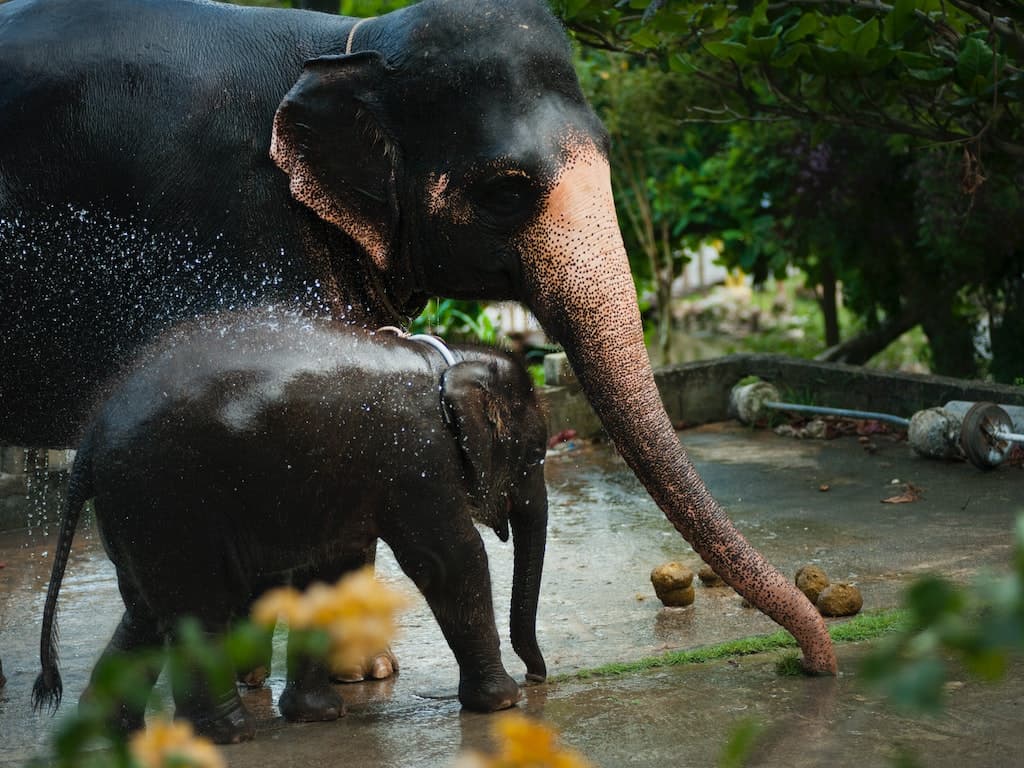Welcome, young animal enthusiasts! Have you ever wondered about animal parenting? Do you know how animals take care of their babies? Well, get ready to learn about the wonderful world of animal parents! From marsupials to penguins, seahorses to kangaroos, animals have unique and fascinating ways of raising their young. In this blog, we will explore some of the most dedicated animal parents in the animal kingdom. So, let’s dive in and discover the amazing ways of animal parenting that animals protect, feed, and care for their babies!
Animal Parenting
Are you familiar with how animal parents raise their young ones? Is it comparable to how our families function? Today, we will delve into the parenting habits of various animals such as Elephant Parents, Kangaroo Parents, Penguin Parents, Mom and Dad Ducks, and more! Although wild animals may appear vastly different from us, they share the commonality of having a mother and father, just like humans.
It is a common observation that in many animal families, the responsibility of taking care of the offspring mostly falls on the mother. However, we will also explore some unique animal parents where the majority of the parental care is assumed by the father! Can you guess which animal fathers take on most of the responsibilities?
Do animals have parenting styles?
As human parents, we are well aware of the responsibilities that come with taking good care of our babies. It takes a great deal of effort and cares to ensure their health and happiness. However, have you ever wondered how animal parents raise their young ones?
The methods employed by animal parents to raise their offspring may come as a surprise to many. There are some incredible tales of animal parents that are fascinating to learn about!
Learn Wild Animal Names And Animal Videos For Kids
Here are examples of animal parenting
Elephants

Elephants are the largest land animals on our planet, which means their offspring are equally sizable. A newborn elephant can weigh over 100 kg and stand approximately one meter tall. It takes about two years for an elephant fetus to fully develop before birth. A baby elephant is referred to as a calf and remains close to its mother, nursing for up to six years after birth.
Elephant mothers are not alone in raising their young ones. Similar to the saying, “it takes a village to raise a child,” elephant herds collectively participate in taking care of their newest member. Elephant herds are led by the oldest female elephant, who acts as the leader of the matriarchy. The female elephants in the herd typically stick close together, raising each other’s babies alongside their own. A typical elephant family comprises a mother, her sisters, daughters, and all the baby calves.
The male elephants live on the edges of the herd, sometimes venturing off on their own. However, when an elephant mother and father are expecting a baby, the dad stays close to the mom, providing protection. When an elephant calf is born, the female elephants in the herd trumpet and celebrate the new arrival. The elephant mom assists the calf in standing up, allowing it to nurse.
Like human babies, elephant calves require a lot of assistance from their mothers and the other elephants in the herd. For example, elephant calves do not know how to use their trunks initially, and it’s the job of the mother and other elephants to teach them how to use it to pick up things, drink water, spray themselves, and eat. Interestingly, one lesson an elephant calf learns is how to cover itself with mud, which serves as a natural sunscreen.
The herd ensures the safety of the baby elephants by intermingling them with the larger, grown-up elephants. It’s fascinating to observe how the elephant herd works together to raise their young, creating a supportive and loving family structure.
Baby Animals Names | Fun Facts About Baby Animals For Kids
Orangutan

Orangutan mothers have the challenging task of raising their babies on their own. These cute little ones require a lot of attention and care, which is why female orangutans typically have offspring only once every eight years. These primates are mainly found in the rainforests of Borneo and Sumatra, spending most of their time in the trees. Orangutans do not form permanent families, as a male and female come together only to mate, after which the male leaves. Once the female gives birth nine months later, she is left to care for the infant herself, sometimes with the help of a sister.
For the first four months of its life, the baby orangutan clings to its mother, who carries it everywhere she goes. Orangutan infants rely entirely on their mothers for the first two years of their lives. One of the mother orangutan’s most important responsibilities is teaching her baby what is safe to eat. Orangutans primarily consume fruit from rainforest trees, but they also eat bark, leaves, insects, honey, and bird eggs. Some orangutans have been observed using twigs as tools to reach insects, and they teach this skill to their offspring.
Orangutans spend most of their day feeding, resting, and travelling from tree to tree. When night falls, they build a nest up in a tree. This is another critical lesson that mother orangutans teach their young. The young orangutan learns by watching its mother build a complex nest. From around 6 months old, the orangutan youngster starts to imitate their mother. They choose a tree and gather branches, braiding them together to create a sturdy base for their bed. Then they arrange smaller branches with leaves to make a comfortable mattress. Some orangutans even add blankets and pillows! It’s amazing to see the lengths these dedicated mothers go to care for their offspring.
Fun Facts About Sea Animals For Kids
Ducks

Do you know how ducks care for their offspring? Unlike mammals, birds lay eggs, and when it’s time for ducks to have babies, they find a safe spot on land to build a nest. Before mating, the male and female ducks work together to create a small hole in the ground near the water, which is usually protected by tall grass. The female duck then plucks some of her own feathers to line the nest and lays one egg per day until she has about a dozen eggs in the soft nest. While the father duck may help guard the eggs, it’s usually up to the mother duck to take care of her babies. She sits on the nest for up to 23 hours a day to keep the eggs safe and warm in a process called “brooding,” and her collection of eggs is called a “brood.”
After about a month, the eggs hatch, and the little ducklings work their way out of the shells by tapping with a sharp bump on their bill called an “egg tooth.” It’s important that the newborn ducklings see their mom when they’re born because of a process called “imprinting,” which means they become attached to the first moving object they see and will follow it everywhere. After all the duck’s hatch, the mother duck spends one more night sitting on the nest, keeping the new hatchlings warm and safe. The next day, the mother duck leads her ducklings to the water, teaching them how to find food, including grasses, worms, insects, and fish. The ducklings grow up fast and start to look and act like little grown-up ducks within two weeks. By imitating their mother, they learn how to swim, dive for food, and eventually fly.
Kangaroos

The kangaroo is an extraordinary type of animal parent due to its status as a marsupial. Marsupials are a class of mammals that give birth to their offspring at a very early stage of development. The young, known as joeys, are not capable of independent living and therefore crawl into a pouch on their mother’s stomach to complete their development. Kangaroo pregnancies are short, lasting only about a month. When a kangaroo joey is born, it is only about the size of a small grape and is too tiny to nurse on its own. As a result, the mother kangaroo secretes milk into her baby’s mouth. The joey will begin to explore the world when it reaches about eight months of age, while still nursing and returning to the pouch. The joey will nuzzle up to its mother when it wants to enter the pouch, and the mother and baby kangaroos are very affectionate with each other, with the mother grooming her young.
After a few months, the mother will say, “you’re all grown up now and ready to live on your own.” However, they will still spend a lot of time together. Kangaroos usually live in family groups of up to 50 individuals. One of the most remarkable things about kangaroos is that the female kangaroo has another baby right away after giving birth. After the birth of her first joey, the mother kangaroo mates again, and the second baby remains a small ball of cells until the first joey leaves the pouch, after which the rest of the pregnancy continues. It is uncommon to see twin kangaroo joeys, but it does happen.
Penguins

Most penguins typically lay one or two eggs and both the mom and dad take turns incubating the eggs by sitting on them to keep them warm, while their mate goes out to feed. However, Emperor Penguin dads are solely responsible for the incubation duties. These penguins reside in Antarctica, where it is extremely cold and a challenging task to keep the eggs safe and warm. The female Emperor Penguin lays only one egg at a time, which is relatively small compared to the size of the mother. The penguin eggs are equipped with extra thick shells to prevent breakage during the handoff from mom to dad.
The male Emperor Penguin keeps the egg warm by placing it on top of his feet and allowing it to rest in his brood pouch, which is a very warm fold of skin and feathers. The male penguins stand together to guard their eggs for about 65 days, taking turns to stay warm. The father penguins do not eat during this period, but the mothers go out hunting for food. After the chicks hatch, the mothers return with chewed-up fish for them. Now it’s the males’ turn to go out and hunt, while the mothers take over the care of the chicks.
The baby penguins look different from their parents, with fuzzy feathers that resemble fur. Once the chicks are big enough, both parents can go fishing while the chicks are left together in a group called a creche, huddling to keep warm while their parents hunt. The mother and father penguins return to feed their chicks with the fish they caught. When the baby penguins start losing their baby feathers, their parents stop feeding them, and soon it becomes warm enough for the ice to melt close to the young penguins. This is when they learn to swim and fish on their own, indicating that it’s time for them to grow up.
Vertebrate Animals For Kids Learning
Animals Parenting Skills
These animals truly exhibit exceptional parenting skills, but it’s important to note that not all animals are fortunate enough to have their parents around to care for them. For instance, many species of insects, fish, and amphibians lay numerous eggs and do not provide any parental care. Nevertheless, there are some remarkable exceptions, such as the seahorse. The seahorse is a peculiar-looking fish that employs a unique method of parenting. The male seahorse possesses a brood pouch on his tail where the female seahorse deposits over a thousand eggs during mating. The seahorse father carries the eggs in his pouch, which provides a secure environment with nutrients and oxygen for the developing offspring. The male seahorse carries the eggs everywhere he goes and every day, the female checks in on her mate. After approximately a month, the eggs hatch, and the tiny seahorse babies emerge.
Animals display many different forms of parenting behavior, based on their socioecology, the energetic constraints of their reproduction (ex. litter size), and their mode of delivering nutrients to the offspring. However, the most extreme forms of parenting exist outside of mammals; for instance, with many amphibians and reptiles not providing care at all, and more than 80% of birds providing biparental care. Source: ncbi
Animal Parents | Animals for Kids | Wild Animal Families
Final Thoughts
So, there you have it. Hope you could learn about animal parenting. Animal parents come in all shapes and sizes, and they take care of their babies in many different ways. From the kangaroo that carries her tiny joey in her pouch to the seahorse dad who carries thousands of eggs in his pouch, animal parents have many unique and amazing ways of taking care of their babies. Remember to appreciate and respect all the different ways that animal parents take care of their young. Who knows, you might even learn something new about how to be a great parent yourself someday!
Those were just a few examples of amazing animal parenting.
Do you know any other interesting animal parents?
Thank you for your visit.
Don’t forget to share it.
Leave your thoughts in the comment box below.
Chat

Mathukutty P. V. is the founder of Simply Life Tips. He is a Blogger, Content Writer, Influencer, and YouTuber. He is passionate about learning new skills. He is the Director of PokketCFO.
He lives with the notion of “SIMPLE LIVING, CREATIVE THINKING”. He Believes – “Sharing is caring.” and “Learning never ends.”



